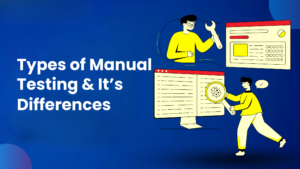

Automation testing is a software testing technique that uses specialised tools and scripts to run predefined test cases, compare the results to what was expected, and report the results.
The fundamental purpose of automated testing is to improve the efficiency, effectiveness, and coverage of the testing process by automating repetitive and time-consuming processes that would otherwise be completed manually
Automation Testing is the key for achieving efficiency, reproducibility, and early bug identification throughout the development process. Automated testing not only speeds up the testing process, allowing for rapid examination of vast codebases, but it helps guarantee software stability by promptly identifying and addressing possible flaws. This strategy shows to be cost-effective in the long run, producing consistent and accurate outcomes while effortlessly integrating with continuous integration and delivery processes.
In this article, we’ll look at several types of automated testing, including examples of developing a strong and speedy software development process.
Component testing is a type of software testing that focuses on specific programme components or modules. A component is a well-defined and independent part of a system that performs a specified function in software development. Component testing involves testing each of these components separately to confirm that they perform properly and satisfy the specifications.
- Enter an invalid user id and see whether any user-friendly warning pop ups appear.
- Enter an invalid user id and password, then click’ reset’ to see if the data in the text fields user-id and password is cleared out.
- Enter a valid user name and password, then press the ‘Login’ button.
- Check to see if the message is displayed on the home page.
- Check to see if all of the web page’s links are clickable.
- Check to see if someone’s id is displayed in the centre of the home page.
- Check for the presence of various images on the home page as shown in the diagram.
Integration testing is a software testing methodology that focuses on checking the interactions of various modules or components of a software system when they are combined. The purpose of integration testing is to guarantee that these integrated components perform as intended and interact properly. This testing phase follows unit testing (individual component testing) and comes before system testing (testing the entire system as a whole).
Examples of Integration testing:
- Validate navigation from amazon web page to amazon login page.
- Validate navigation from amazon login page to amazon password page.
- Validate navigation from amazon password page to amazon home page
- Validating navigation to ‘Career’ page by scrolling down and clicking on ‘Career’ link in amazon home page
- Validating navigation to ‘About us’ page by scrolling down and clicking on ‘About us’ link in amazon home page.
- Validating navigation to ‘Press Releases’ page by scrolling down and clicking on ‘Press Releases’ link in amazon home page.
System testing is a complete stage of software testing that assesses the complete software system. It is performed after integration testing and focuses on making sure the entire system, including all integrated components, performs as stated and behaves as expected in a real-world setting.
Example of System Testing:
- Validation of login in amazon application->Searching the product->Adding it to wishlist->Adding it to cart->Making the payment from credit card->Logging out
- Validation of login in amazon application->Searching the product->Adding it to wishlist->Adding it to cart->Making the payment from debit card->Logging out
- Validation of login in amazon application->Searching the product->Adding it to wishlist->Adding it to cart->Making the payment from UPI payment->Logging out
- Validation of login in amazon application->Searching the product->Adding it to wishlist->Adding it to cart->Making the payment from Net banking->Logging out
- Validation of login in amazon application->Searching the product->Adding it to wishlist->Adding it to cart->Making the payment from Amazon pay->Logging out
- Validation of login in amazon application->Searching the product->Adding it to wishlist->Adding it to cart->Making the payment from gift card->Logging out
Acceptance testing is the last phase of the software testing process, and it is used to verify whether a software system meets the requirements and is ready for delivery to end users or stakeholders. Acceptance testing’s primary goal is to check that the software meets the business and functional guidelines provided in the project documentation.
Examples of Acceptance Testing:
- Check that users may log in with proper credentials (for example, a registered username/email and password).
- When users attempt to log in with invalid credentials (e.g., an incorrect password or a non-existent username), verify that they receive an error message.
- After a certain amount of failed login attempts, the account is locked and the user is unable to log in.
- To test the password reset feature, click the “Forgot Password” link and submit a password reset request.
- To guarantee that the user remains logged in across browser sessions, test the “Remember Me” option.
- Log in with valid credentials to test the MFA implementation and ensure that the MFA method (e.g., SMS code, app-based token) works properly.
Smoke testing, also known as build verification testing or logic testing, is an early stage of software testing used to verify that a software build’s basic functionality is correct. The term “smoke testing” comes from the hardware testing track, when a device or part is looked at to check if it burns or releases smoke during its initial use. In the context of software, smoke testing assures that an application’s important and essential capabilities are operational following a new version or release.
Examples of Smoke testing:
- To verify that the user is able to browse the Amazon.in website in different browsers like chrome ,Firefox, etc.
- To verify that User is able to create an account in amazon.in website
- To verify that the user is able to login to the amazon.in website.
- To verify that the Amazon.in website homepage loads successfully after clicking on the sign in button.
- To verify searching for a product on amazon.in website.
- To verify that the product listing page is displaying the appropriate product for the related search query.
Ad hoc testing is a type of software testing that is done on the fly with no preset test cases or procedures. The phrase “ad hoc” is Latin meaning “as needed” or “for this purpose,” and it reflects the unstructured and impromptu character of this testing approach. Ad hoc testing is frequently exploratory in nature, with testers relying on their expertise, intuition, and domain knowledge to identify bugs or issues in software.
Examples of Ad hoc Testing :
- Running the app through tests across multiple platforms. It is vital to make sure that the finished programme functions smoothly across a wide range of operating systems and browsers.
- Giving the system inputs that are outside of the valid-inputs range to verify if the application’s response is appropriate.
- To launch the application in a different browser, copy and adjust the URL. This is done to avoid unauthorised users from gaining unauthenticated access to the system.
- Going through a series of random actions or randomly moving around the programme in order to validate the results obtained by employing an odd combination of inputs.
Keyboard-driven testing, also known as keyboard-based testing or keyboard automation, is a method of software testing in which the tester interacts with the programme being tested using keyboard inputs. This method automates testing activities by replicating user interactions using keyboard commands such as key presses and keyboard shortcuts. The primary purpose is to validate the software’s functionality and behaviour from the standpoint of the user.
Examples of Keyboard Testing:
- TC_01: Access a demo site and determine how many transactions were completed today.
- Log on to a demo site, send an email to one of your customers, and then log out.
- TC_03: Access a demo site and look for any notifications.
Regression testing is a type of software testing that focuses on verifying that changes to the software, such as bug patches, additions, or new features, do not have a negative impact on the application’s present functionality. The primary purpose of regression testing is to check that no new problems have been introduced by the new code changes and that previously working functionality continues to function as intended.
Examples of Regression Testing:
- A user can log into an app using their username and password or their Gmail account if the app is integrated with Google.
- LinkedIn integration is a new feature that allows users to enter into the app using their LinkedIn account.
- While it is important to make sure that LinkedIn login works as intended, it is also critical to verify that alternative login methods (form login and Google integration) continue to work.
Unit testing is a technique to assess individual units or components of a software application in isolation. The fundamental purpose of unit testing is to make sure that each unit of software behaves as expected and functions properly before it is merged into the bigger system. Units are the smallest tested components of a programme, which are frequently isolated functions, methods, or processes.
Examples of Unit Testing:
- Mock objects are used in unit testing to test pieces of code that are not yet part of a complete application. Mock objects stand in for missing programme components.
For example, you could have a function that requires variables or objects that have not yet been created. Those will be accounted for in unit testing in the form of mock objects produced expressly for the purpose of unit testing on that portion of code.
Data-driven testing is a method of software testing in which test scripts are written to run with changing sets of data inputs. The test data is isolated from the test script in this testing approach, allowing the same test script to be executed with different sets of input values. The fundamental purpose of data-driven testing is to validate the software’s functionality and behaviour under various data situations, maintaining that it generates correct results for a wide range of input scenarios.
Example of Data Driven Testing:
-
TestData.csv (Comma Separated Values) is the name of the test data file.
-
This file contains the driver script’s inputs and its expected outputs, which are indicated in the table below.
-
For the data in question file, the driver script will be data = open(‘TestData.csv’).lines = data.splitlines() read()
-
The following are the steps taken for the aforesaid driver scripts:
1 Read Value
Value2 should be read.
Operator for reading - Use an operator on Value1 and Value2 to compute the results.
- Finally, compare the expected and actual results.
Performance testing is a type of software testing that assesses how a system performs under varied workloads in terms of responsiveness, speed, scalability, stability, and overall reliability. Performance testing is used to discover and address any performance issues, problems, and flaws in software or hardware infrastructure before it is deployed in a production setting.
Examples of performance testing :
- Verify that the response time is less than 4 seconds when 1000 users access the website at the same time.
- Test Case 02: Verify that the Application Under Load’s response time is within an acceptable range when network connectivity is slow.
- Test Case 03: Find the maximum number of users that the application can support before failing.
- Test Case 04: Calculate the database execution time when 500 records are read/written at the same time.
- Check the CPU and memory use of the application and database server during high load conditions.
- Test Case 06: Verify the application’s reaction time under low, normal, moderate, and heavy load circumstances.
Security testing is a type of software testing that focuses on discovering flaws, vulnerabilities, and potential security threats in a software application or system. The major purpose of security testing is to guarantee that the programme can withstand external threats, safeguard sensitive data, and maintain information confidentiality, integrity, and availability.
Examples of Security Testing:
- Passwords stored must be encrypted in the database.
- Penetration testing like SQL injection must be tested.
- Data transfer from UI to API must also be encrypted.
- Sessions and Cookies must be tested for security.
In conclusion, automated testing plays a crucial role in improving software quality by identifying issues early and ensuring consistent performance. By understanding the different types of automated testing, such as unit testing, integration testing, and end-to-end testing, you can take a more comprehensive approach to testing your software and catching potential issues before they impact your users.
If you want to develop your automation testing skills, we recommend checking out our Automation Software Testing Course. This course will help you learn the skills to get top-notch knowledge on software testing, truly upskill your career, and open up new opportunities in the ever-evolving world of software testing.
Consult Us


















